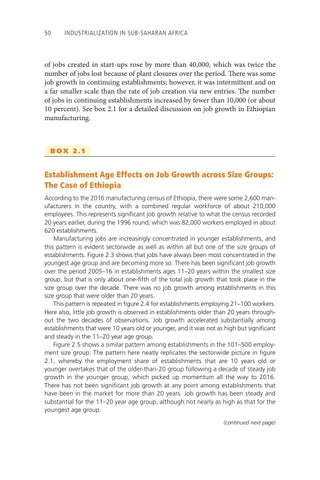50 Industrialization in Sub-Saharan Africa
of jobs created in start-ups rose by more than 40,000, which was twice the number of jobs lost because of plant closures over the period. There was some job growth in continuing establishments; however, it was intermittent and on a far smaller scale than the rate of job creation via new entries. The number of jobs in continuing establishments increased by fewer than 10,000 (or about 10 percent). See box 2.1 for a detailed discussion on job growth in Ethiopian manufacturing.
BOX 2.1
Establishment Age Effects on Job Growth across Size Groups: The Case of Ethiopia According to the 2016 manufacturing census of Ethiopia, there were some 2,600 manufacturers in the country, with a combined regular workforce of about 210,000 employees. This represents significant job growth relative to what the census recorded 20 years earlier, during the 1996 round, which was 82,000 workers employed in about 620 establishments. Manufacturing jobs are increasingly concentrated in younger establishments, and this pattern is evident sectorwide as well as within all but one of the size groups of establishments. Figure 2.3 shows that jobs have always been most concentrated in the youngest age group and are becoming more so. There has been significant job growth over the period 2005–16 in establishments ages 11–20 years within the smallest size group, but that is only about one-fifth of the total job growth that took place in the size group over the decade. There was no job growth among establishments in this size group that were older than 20 years. This pattern is repeated in figure 2.4 for establishments employing 21–100 workers. Here also, little job growth is observed in establishments older than 20 years throughout the two decades of observations. Job growth accelerated substantially among establishments that were 10 years old or younger, and it was not as high but significant and steady in the 11–20 year age group. Figure 2.5 shows a similar pattern among establishments in the 101–500 employment size group. The pattern here neatly replicates the sectorwide picture in figure 2.1, whereby the employment share of establishments that are 10 years old or younger overtakes that of the older-than-20 group following a decade of steady job growth in the younger group, which picked up momentum all the way to 2016. There has not been significant job growth at any point among establishments that have been in the market for more than 20 years. Job growth has been steady and substantial for the 11–20 year age group, although not nearly as high as that for the youngest age group. (continued next page)

